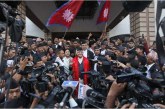
|
By Mrs. Shewta Kumar |
|
The outcome of recently-held state assembly elections in Bihar points to a social, political and economic paradigm shift in the State in the past five years.
The magnitude of this victory registered by the JD (U)-BJP combine can be explained in three simple statistics. In the first place, it is the biggest electoral victory in the annals of Bihar in terms of seats; the vote percentage of the winning combine is approximately 42 per cent, a huge jump from the 36 per cent it had five years ago. Secondly, the average victory margin of JD(U)-BJP candidates is as high as 16,500 votes. Thirdly, both the JD(U) and the BJP recorded significant percentage wins vis-a-vis the number of seats they contested. The JD(U) won 82 per cent of the seats it contested and the BJP, a phenomenal 90 per cent. The truimphant Nitish Kumar made no secret of the fact that the massive victory had taken him too by surprise though he had consistently maintained that there was a social, political and economic paradigm shift in the State in the last five years under him. Addressing the media, Nitish Kumar said that what he had got was not a mere mandate to come back to power but also a huge responsibility and the additional burden of tremendous expectations of the people. He said: “The victory is theirs, and what I have got from now on is a tough job.” Interestingly, the increase in the vote share, cutting across caste, religious and gender lines, was spread across almost all regions. The regions where the ruling alliance’s vote share witnessed an upsurge included the Muslim-dominated Seemanchal, the areas bordering Nepal, and other districts such as Purnea, Katihar, East Champaran, West Champaran, Araria, Darbhanga, Siwan and Bhagalpur with a high concentration of Muslims. The people of the flood-ravaged Kosi region reposed the same confidence they had placed in the JD(U)-BJP combine in the 2009 Lok Sabha elections. The Saran region, where once the Muslim-Yadav combination held sway, voted for the combine this time. During the early stages of the Bihar Assembly elections, Chief Minister Nitish Kumar frequently repeated went like this statement: “My friends Lalu ji and Paswan ji are still clinging to the old political and electoral syllabus, which is based entirely on caste permutations and combinations. This election will make them understand that these paradigms have changed and that development has become the key factor. Indeed, they will be brought to this realisation with a thud.” And this exactly happened after the results were out. Viewed in a broad spectrum, it was not just Rashtriya Janata Dal (RJD) chief Lalu Prasad and Lok Janshakti Party (LJP) leader Ram Vilas Paswan, about whom Nitish made this reference, who held on to old beliefs. Significantly, many in his own Janata Dal (United) and in the Bharatiya Janata Party (BJP), partner in the National Democratic Alliance (NDA) coalition, were sceptical about the scope and depth of the shift. According to media reports, even the Nitish Kumar did not have a clear assessment of the import of this change. But the election results asserted emphatically the radical change in Bihar’s political scene. The proclaimed paradigm shift in Bihar do point towards some regrouping at the national level, which may ultimately strengthen the opposition to the ruling Congress-led United Progressive Alliance. However, what exactly the final ideological contours of such regrouping would take shape, is seemingly in the realm of speculation. |

 In the recently-held state assembly polls in Bihar, the JD (U)-BJP combine virtually swept the elections, winning as many as 206 of the 243 seats. Of this, the JD(U) accounted for 115 seats and the BJP 91. The coalition’s electoral juggernaut eliminated almost all its adversaries, including the principal opposition RJD-LJP combine and the Congress. The Left combination consisting of the Communist Party of India (Marxist-Leninist), the Communist Party of India and the Communist Party of India (Marxist), too, suffered an ignominious defeat. When the RJD-LJP alliance won 25 seats (22 RJD, 3 LJP), the Congress won in four constituencies; the CPI won just a seat. Independents and others accounted for six seats.
In the recently-held state assembly polls in Bihar, the JD (U)-BJP combine virtually swept the elections, winning as many as 206 of the 243 seats. Of this, the JD(U) accounted for 115 seats and the BJP 91. The coalition’s electoral juggernaut eliminated almost all its adversaries, including the principal opposition RJD-LJP combine and the Congress. The Left combination consisting of the Communist Party of India (Marxist-Leninist), the Communist Party of India and the Communist Party of India (Marxist), too, suffered an ignominious defeat. When the RJD-LJP alliance won 25 seats (22 RJD, 3 LJP), the Congress won in four constituencies; the CPI won just a seat. Independents and others accounted for six seats.

